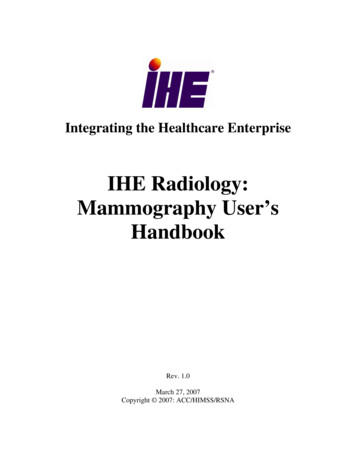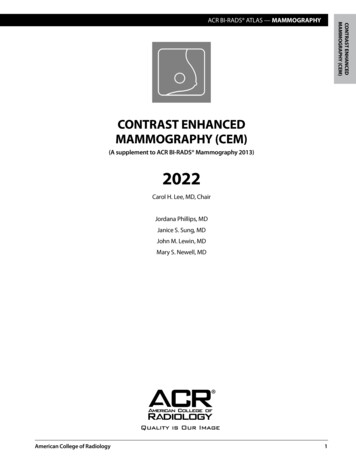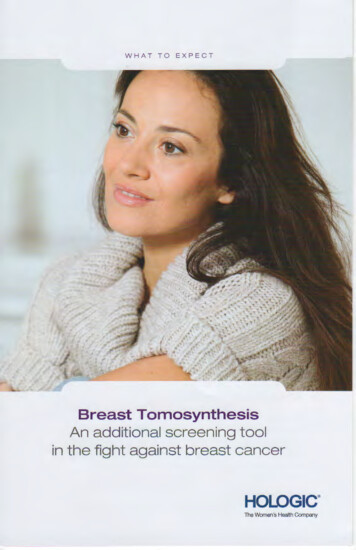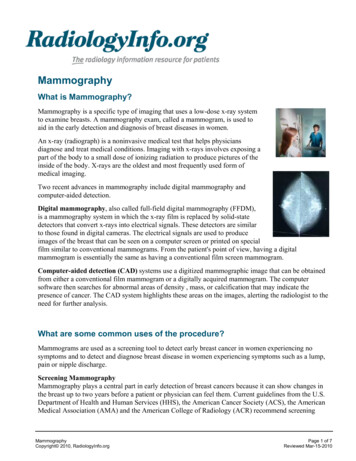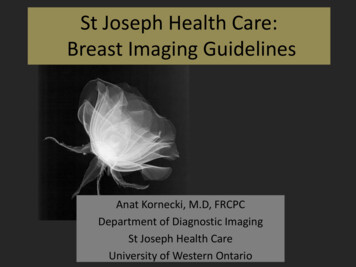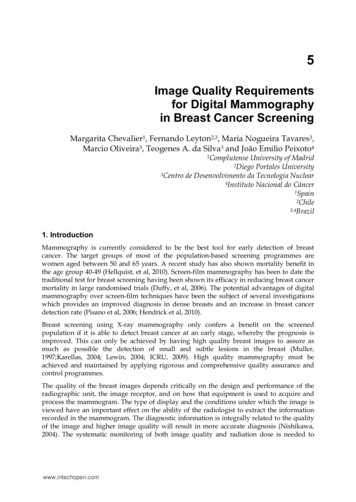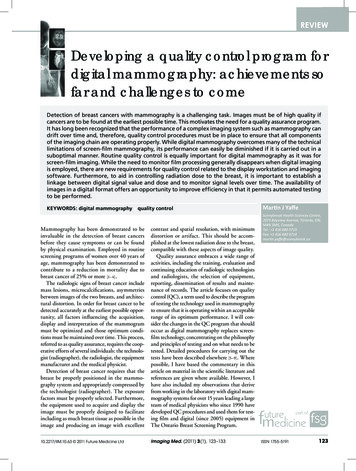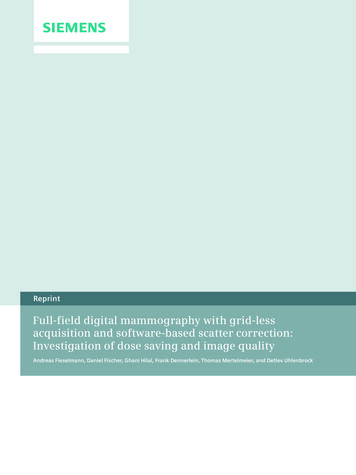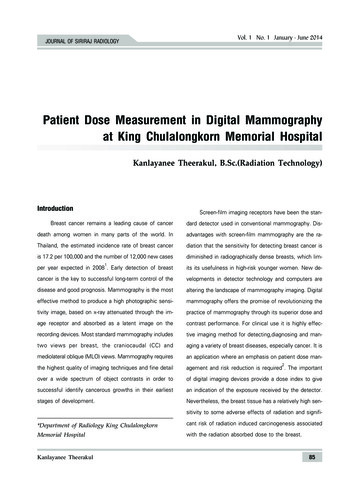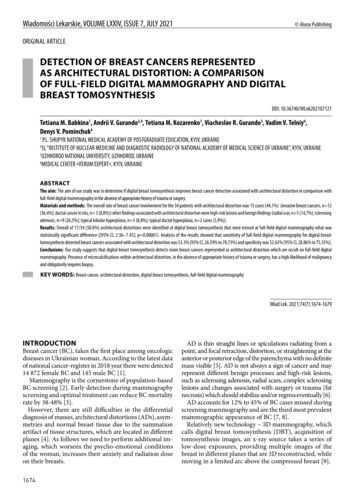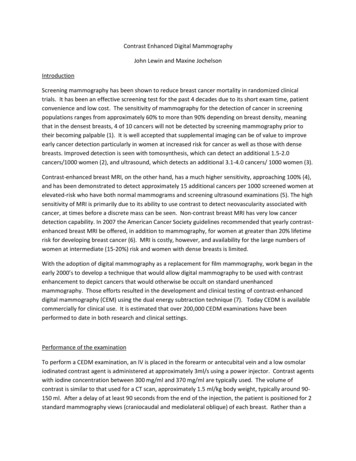
Transcription
Contrast Enhanced Digital MammographyJohn Lewin and Maxine JochelsonIntroductionScreening mammography has been shown to reduce breast cancer mortality in randomized clinicaltrials. It has been an effective screening test for the past 4 decades due to its short exam time, patientconvenience and low cost. The sensitivity of mammography for the detection of cancer in screeningpopulations ranges from approximately 60% to more than 90% depending on breast density, meaningthat in the densest breasts, 4 of 10 cancers will not be detected by screening mammography prior totheir becoming palpable (1). It is well accepted that supplemental imaging can be of value to improveearly cancer detection particularly in women at increased risk for cancer as well as those with densebreasts. Improved detection is seen with tomosynthesis, which can detect an additional 1.5-2.0cancers/1000 women (2), and ultrasound, which detects an additional 3.1-4.0 cancers/ 1000 women (3).Contrast-enhanced breast MRI, on the other hand, has a much higher sensitivity, approaching 100% (4),and has been demonstrated to detect approximately 15 additional cancers per 1000 screened women atelevated-risk who have both normal mammograms and screening ultrasound examinations (5). The highsensitivity of MRI is primarily due to its ability to use contrast to detect neovascularity associated withcancer, at times before a discrete mass can be seen. Non-contrast breast MRI has very low cancerdetection capability. In 2007 the American Cancer Society guidelines recommended that yearly contrastenhanced breast MRI be offered, in addition to mammography, for women at greater than 20% lifetimerisk for developing breast cancer (6). MRI is costly, however, and availability for the large numbers ofwomen at intermediate (15-20%) risk and women with dense breasts is limited.With the adoption of digital mammography as a replacement for film mammography, work began in theearly 2000’s to develop a technique that would allow digital mammography to be used with contrastenhancement to depict cancers that would otherwise be occult on standard unenhancedmammography. Those efforts resulted in the development and clinical testing of contrast-enhanceddigital mammography (CEM) using the dual energy subtraction technique (7). Today CEDM is availablecommercially for clinical use. It is estimated that over 200,000 CEDM examinations have beenperformed to date in both research and clinical settings.Performance of the examinationTo perform a CEDM examination, an IV is placed in the forearm or antecubital vein and a low osmolariodinated contrast agent is administered at approximately 3ml/s using a power injector. Contrast agentswith iodine concentration between 300 mg/ml and 370 mg/ml are typically used. The volume ofcontrast is similar to that used for a CT scan, approximately 1.5 ml/kg body weight, typically around 90150 ml. After a delay of at least 90 seconds from the end of the injection, the patient is positioned for 2standard mammography views (craniocaudal and mediolateral oblique) of each breast. Rather than a
standard single energy mammogram, however, the CEM device acquires dual-energy image pairs in eachprojection. Since there is less than 1 second between the low-energy and high energy images, theimaging time is the same as that needed for a standard mammogram. Additional projections may beobtained since optimally enhanced images can typically be obtained up to 7-10 minutes followinginjection (8).Following image acquisition, contrast-enhanced subtraction images are produced using a weightedlogarithmic subtraction of the low energy image from the high energy image. Because the difference iniodine absorption between the images is larger than the difference in tissue absorption, this dual energysubtraction technique has the effect of increasing the visibility of the iodine while almost completelyeliminating the visibility of background tissue. The resulting images are sent to a review workstation orPACS for interpretation by the radiologist. The low energy images, which are identical to standardunenhanced mammograms (9, 10), are also used in the interpretation. Figure 1 shows an example of atypical CEDM study. Since there is typically only a single time point for each image, no kineticinformation is available.The risks of CEDM include the risks of contrast administration including allergic reactions and renalfunction abnormalities. Just as with CT, patients should be screened for allergy history and possiblerenal function abnormalities. Allergic or physiologic reaction are reported to occur in less than 1% ofpatients when using low osmolar contrast agents although this increases in patients with priorreactions(11,12). Severe acute reactions occur in 4/10,000 (0.04%) of patients (13). It is also thereforeincumbent that breast imaging radiologists be familiar with the treatment of contrast reactions.Literature ReviewSo far, most of the published data on the performance of CEDM stem from use in the diagnostic setting,i.e., patients with abnormal screening mammograms and/or symptoms. As would be predicted, multiplestudies have shown that CEDM is more sensitive for the detection of cancer than standard unenhancedmammography (14, 15). These studies also showed CEDM to be more accurate, as measured by the areaunder the receiver operating characteristic (ROC) curve. In women with dense breasts, Cheung et aldemonstrated that CEDM is superior to mammography in both sensitivity with improvement from 71.5%to 92.7% and specificity from 51.8% to 67.9%(16).More interesting is the comparison of CEDM to contrast-enhanced breast MRI. A European study of 80subjects with newly diagnosed breast cancer showed equivalence in detection of the index cancerbetween CEDM and MRI, with the trend favoring CEDM (80/80 for CEDM vs 78/80 for MRI) (17). Asimilarly designed study at Memorial Sloan Kettering with 52 subjects also showed equal sensitivitybetween CEDM and MRI (50/52 for each) (6). MRI found more additional malignant foci (22/25 vs14/25) but at the cost of more false positives (13 vs 2) (6). Of interest, just as with MRI, the sensitivity ofcontrast enhancement on CEDM for detection of cancers manifesting as microcalcifications is morelimited than for those evident as masses (18). For this reason, suspicious microcalcifications seen on thelow energy images should be biopsied even if they do not show surrounding enhancement. A study from
Hobbes et al (19) has demonstrated that patients prefer CEDM to MRI since patients are averse to thenoise and claustrophobia associated with breast MRI.A two-site Taiwan – U.S. study of a mixture of malignant and benign lesions used receiver operatingcurve (ROC) analysis to compare CEDM, MRI and contrast-enhanced tomosynthesis, an experimentaltechnique in which dual energy tomosynthesis is performed following a contrast injection. The studyfound no difference among the three techniques in accuracy by area under the ROC curve (20). Thestudy also included two non-contrast enhanced techniques, mammography and digital breasttomosynthesis. As expected from earlier results, the two contrast-enhanced techniques performedsignificantly better than the non-contrast enhanced techniques. The addition of contrast-enhancedtomosynthesis to CEDM did not result in improved accuracy.Proposed uses for CEDMWith the promising data in the diagnostic setting, a frequent use of CEDM is to further evaluate eitherclinical or imaging abnormalities from abnormal screening exams. This has the additional advantage ofdoubling as a preoperative extent-of-disease exam in those patients who are diagnosed with cancer.Due to its superior specificity in this setting, CEDM has the potential to reduce unnecessary biopsy ofbenign low suspicion (BI-RADS 4a) masses. Ongoing studies are investigating its use for this purpose.CEDM can be used in situations where contrast-enhanced breast MRI would be employed, includingstaging of a newly diagnosed cancer and problem solving where conventional imaging, i.e.mammography (or tomosynthesis) and ultrasound, fail to resolve an ambiguous finding on screeningmammography. CEDM is also under investigation as a means of monitoring response to neoadjuvantchemotherapy; preliminary results are promising [Lotti, V. Presented at RSNA 2016, Abstract SSJ01-06].CEDM may be useful for screening women at high risk of developing breast cancer; high-risk screeningresearch studies are currently in progress.A major barrier to widespread use of CEDM at this time is the inability to perform CEDM-guided biopsyalthough there is a prototype in development. Lesions detected on CEDM that can be seen on lowenergy images may undergo stereotactic biopsy. If there is a mass that can be seen on ultrasound,ultrasound guidance can be used. Otherwise, an MRI may be required; as the lesions are usuallyapparent on MRI so that MR-guided biopsy may be performed.LexiconWork is under way to develop a standardized lexicon for CEDM for incorporation into the AmericanCollege of Radiology Breast Imaging and Reporting Data System (BI-RADSTM). Under consideration is ascoring system that will include a combination of the BI-RADS assessment of the low energymammogram with an adaptation of the feature descriptors from the MRI BI-RADS lexicon withoutkinetics.
SummaryBased on its ability to image neovascularity in a fashion similar to MRI, CEDM is a promising techniquefor depicting cancers that are not visible on standard unenhanced mammography. It is approved forclinical use and is performed on commercial systems. Results of clinical studies show it to besignificantly more sensitive and specific than mammography alone and to have sensitivity and specificitycomparable to contrast-enhanced breast MRI. Current and proposed uses include additional evaluationof symptomatic patients or patients with abnormal screening examinations, assessing local extent ofnewly diagnosed breast cancers, problem solving, monitoring of neoadjuvant chemotherapy and highrisk screening.REFERENCES1. Rosenberg RD, Hunt WC, Williamson MR. Effects of age, breast density, ethnicity, and ERT onscreening mammographic sensitivity and cancer stage at diagnosis: review of 183,134 screeningmammograms in Albuquerque, New Mexico. Radiology 1998;209:511-518.2. Friedewald SM, Rafferty EA, Rose SL, et al. Breast Cancer Screening Using Tomosynthesis inCombination With Digital Mammography. JAMA. 2014;311(24):2499-2507.3. Weigert JM. The Connecticut Experiment; The Third Installment: 4 Years of Screening Women withDense Breasts with Bilateral Ultrasound. Breast J. 2017 Jan;23(1):34-39.4. Kuhl CK, Schrading S, Leutner CC, et al. Mammography, breast ultrasound, and magnetic resonanceimaging for surveillance of women at high familial risk for breast cancer. J Clin Oncol 2005;23(33):84698476.5. Berg WA, Zhang Z, Lehrer D, et al. Detection of breast cancer with addition of annual screeningultrasound or a single screening MRI to mammography in women with elevated breast cancer risk. JAMA2012;307(13):1394-1404.6. Saslow D, Boetes C, Burke W, et al. American Cancer Society Guidelines for Breast Screening withMRI as an Adjunct to Mammography. CA Cancer J Clin 2007;57(2):75-89.7. Lewin JM, Isaacs PK, Vance V, Larke FJ. Dual-energy contrast-enhanced digital subtractionmammography: feasibility. Radiology 2003;229(1):261-268.8. Jochelson MS, Dershaw DD, Sung JS, et al. Bilateral contrast-enhanced dual-energy digitalmammography: feasibility and comparison with conventional digital mammography and MR imaging inwomen with known breast carcinoma. Radiology 2013;266(3):743-751.
9. Francescone MA, Jochelson MS, Dershaw DD, et al. Low energy mammogram obtained in contrastenhanced digital mammography (CEDM) is comparable to routine full-field digital mammography(FFDM). Eur J Radiol 2014;83(8):1350-1355.10. Lalji UC, Jeukens CR, Houben I, et al. Evaluation of low-energy contrast-enhanced spectralmammography images by comparing them to full-field digital mammography using EUREF image qualitycriteria. Eur Radiol 2015;25(10):2813-2820.11. Hunt CH, Hartman RP, Hesley GK (2009) Frequency and severity of adverse effects of iodinated andgadolinium contrast materials: retrospective review of 456,930 doses. AJR Am J Roentgenol 193:1124112712. Mortele KJ, Oliva MR, Ondategui S, Ros PR, Silverman SG (2005) Universal use of nonionic iodinatedcontrast medium for CT: evaluation of safety in a large urban teaching hospital. AJR Am J Roentgenol184:31-3413. Katayama H, Yamaguchi K, Kozuka T, Takashima T, Seez P, Matsuura K (1990) Adverse reactions toionic and nonionic contrast media. A report from the Japanese Committee on the Safety of ContrastMedia. Radiology 175:621-62814. Dromain C, Thibault F, Muller S, et al. Dual-energy contrast-enhanced digital mammography: initialclinical results. Eur Radiol 2011;21(3):565-574.15. Lobbes MB, Lalji U, Houwers J, et al. Contrast-enhanced spectral mammography in patientsreferred from the breast cancer screening programme. Eur Radiol 2014;24(7):1668-1676.16. Cheung YC, Lin YC, Wan YL, et al. Diagnostic performance of dual-energy contrast-enhancedsubtracted mammography in dense breasts compared to mammography alone: interobserver blindreading analysis. Eur Radiol 2014;24(10):2394-2403.17. Fallenberg EM, Dromain C, Diekmann F, et al. Contrast-enhanced spectral mammography: Doesmammography provide additional clinical benefits or can some radiation exposure be avoided? BreastCancer Res Treat 2014;146(2):371-381.18. Cheung YC, Juan YH, Lin YC, et al. Dual-Energy Contrast-Enhanced Spectral Mammography:Enhancement Analysis on BI-RADS 4 Non-Mass Microcalcifications in Screened Women. PLoS One2016;11(9):e0162740.19. Hobbs MM, Taylor DB, Buzynski S, Peake RE. Contrast-enhanced spectral mammography (CESM)and contrast enhanced MRI (CEMRI): Patient preferences and tolerance. J Med Imaging Radiat Oncol2015;59(3):300-305.20. Chou CP, Lewin JM, Chiang CL, et al. Clinical evaluation of contrast-enhanced digitalmammography and contrast enhanced tomosynthesis--Comparison to contrast-enhanced breast MRI.Eur J Radiol 2015;84(12):2501-2508.
FIGURESABCFigure 1. Contrast-enhanced digital mammography study of a 54-year-old female with a previouslybiopsied grade 2 invasive ductal carcinoma of the left breast. A. Low- energy MLO mammogram(equivalent to a standard unenhanced mammogram) shows the metallic marker at the cancer site, butthe cancer is obscured by heterogeneously dense parenchyma. B. Corresponding dual-energysubtraction image clearly depicts the cancer (arrow) as an intensely enhancing irregular mass. Note thatthe background non-enhancing fibroglandular tissue is subtracted out. C. Image from a contrastenhanced MRI performed the following day shows the lesion as an enhancing irregular mass (arrow).Note the similarity of the appearance on the CEDM and MRI studies.
ABCDFigure 2. 48-year-old woman with screening detected invasive lobular carcinoma. Standard MLO andCC mammograms (A,B) show extremely dense parenchyma with subtle distortion on the CC view (longarrow). MLO and CC CEDM subtracted images (C,D) show the cancer as segmental nonmass clumpedenhancement (short arrows).
Figure 3. 56-year-old woman with heterogeneously dense breasts on standard mammography (upperimages) and moderate risk of breast cancer. Screening CEDM (lower images) shows focal enhancementin the left breast at 8 o’clock (arrow). The finding was identified on ultrasound, and US-guided biopsyshowed invasive ductal carcinoma. Note the background parenchymal enhancement, analogous to thatseen in contrast-enhanced MRI. Images courtesy of Jennifer Harvey, MD.
Figure 4. High-risk screening CEDM. 57-year-old woman with high lifetime risk of breast cancer due tofamily history. Standard digital mammograms (upper images) show heterogeneously dense parenchyma,benign-appearing round mass upper right breast and surgical clips left breast. Patient chose to undergoCEDM (lower images) instead of MRI due to high out-of-pocket costs with MRI. Non-mass enhancementis seen in the right breast at 4 o’clock (arrows). Biopsy of an US correlate showing fibrocystic changeswas considered discordant. Excisional biopsy showed high grade DCIS. Images courtesy of JenniferHarvey, MD.
enhanced digital mammography (CEDM) is comparable to routine full-field digital mammography (FFDM). Eur J Radiol 2014;83(8):1350-1355. 10. Lalji UC, Jeukens CR, Houben I, et al. Evaluation of low-energy contrast-enhanced spectral mammography images by comparing them to full-field digital mammography using EUREF image quality criteria.
